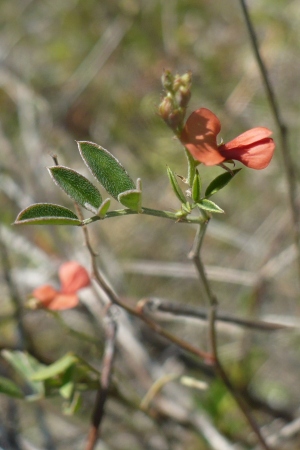Plants of South Florida · Plants by Conservation Area · Plants by County · Plants by Habitat Quick Search · Advanced Search |
||
|
|
||
 |
Indigofera mucronata Spreng. ex DC. var. keyensis (Small) Isley Florida Keys indigo |
|
|
South Florida Status: Critically imperiled. Five occurrences in four conservation areas (John Pennekamp Coral Reef State Park; Long Key State Park; Snake Creek Hammocks; Windley Key Fossil Reef Geological State Park), and two non-conservation areas (Burnt Point Florida Keys Indigo Site & Valhalla Rock Barren). Taxonomy: Dicotyledon; Fabaceae. Habit: Perennial herb. Distribution: Endemic to South Florida. South Florida Distribution: Collier and Miami-Dade counties, and the Monroe County Keys. South Florida Habitats: Rockland hammocks, coastal rock barrens, coastal berms, and shell mounds. Protection Status: Listed as endangered by FDACS and as critically imperiled by FNAI. Currently under review for listing by USFWS (2001). Aids to Identification: Chafin 2000 has illustrations and a color photo; the IRC Website has a color photo. References: Chapman, 1883; Small, 1933a; Long & Lakela, 1976; Avery & Loope, 1980a; Isely, 1990; Wunderlin, 1998, Bradley & Gann, 1999b; Coile, 2000. Synonyms: I. keyensis Small; I. subulata Vahl, misapplied; I. trita L. f. subsp. scabra (Roth) de Kort & Thijsse. Historical Context: John Loomis Blodgett first collected Florida Keys indigo between 1838 and 1853 on Lignumvitae Key (s.n., NY). This is the only collection known from that island. Additional collections have been made from Key Largo (Curtiss 586, NY, US) south to Knights Key (Britton 552, NY). It is apparently extirpated on Knights Key, Lignumvitae Key, and Vaca Key (Simpson 466, NY, US), where it was last observed in 1964 by George N. Avery (Avery’s Notes, 20 June 1964). Florida Keys indigo is extant on Key Largo where Allan H. Curtiss collected it first in 1880 (586, NY, US). William G. Atwater also made a collection there in 1959, with the locality given as “along shore” (M-170, FLAS). Avery observed plants in 1964 on private property later added to John Pennekamp Coral Reef State Park (Avery’s Notes, 11 September 1964). These plants were observed by Gann and Bradley in 1995, and by Gann and Florida Park Service biologist Janice A. Duquesnel in 1998. Fewer than 10 plants were present. This station needs to be vouchered. John Kunkel Small made a collection on Lower Matecumbe Key in 1907 (s.n., NY), a station that also was vouchered by Small in 1917 (8390, NY), Small and others in 1925 (11595, NY), Harold N. Moldenke in 1930 (625, NY), and S. Mori and C. Gracie in 1988 (18790, NY). Gann and Duquesnel rediscovered this population in 2000 at the Klopp Tract, Lignumvitae Key Botanical State Park. Unfortunately, this population may have been destroyed by an exotic species control project. In 1958, W.L. Stern and K.L. Chambers made the first collection on Crawl Key (340, NY, US), a station that was observed by Avery in 1966 (Avery’s Notes, 19 April 1966). Bradley found plants there in 1998 at the privately owned Valhalla Rock Barren Site, which is immediately adjacent to Curry Hammock State Park. Several hundred plants are still present. Plants were also reported for the privately owned Burnt Point Florida Keys Indigo Site on nearby Long Point Key (Ross & Ruiz, 1996), but this station needs to be surveyed. Avery also observed Florida Keys indigo on Long Key in what is now Long Key State Park (Avery’s Notes, 19 April 1966). Carol Lippincott vouchered this station in 1991 (s.n., FTG). This station also was reported by Kruer (1992) and Ross & Ruiz (1996). Gann, Bradley, and Duquesnel have observed plants there as recently as 2000. Several hundred plants may be present at this station, but a thorough census is needed. In 1965, Avery also noted plants on Craig Key, which is located between Long Key and Crawl Key (Avery’s Notes, 20 January 1965), but this is a fill island and is not considered a natural population. In 1962, Frank C. Craighead collected a specimen on Upper Matecumbe Key (s.n., USF). Karen Achor observed plants there in 1982 in privately owned Teatable Hammock (in Weiner 1980, as amended). Bradley has searched for Florida Keys indigo there, but has not been able to locate any plants. More survey work is needed at that station. Conrad Byrd made the first collection on Windley Key in 1968 (s.n., FTG), in what is now Windley Key Fossil Reef Geological State Park. This station also was reported by Kruer (1992), and has been observed as recently as 2000 by Gann, Bradley, and Duquesnel. In 1999, Bradley discovered an additional population on Plantation Key at Snake Creek Hammocks, Florida Keys Wildlife and Environmental Area, but this station needs to be vouchered. Bradley and Woodmansee observed plants there again in 2000 (Bradley et al., 2000b). Two collections were made outside of the Florida Keys in the 1800s. Abram P. Garber made a collection in 1877 in Miami (s.n., NY, US). Alvan W. Chapman made a second collection (s.n., NY) in the 1800s on “Robert’s Key. Caximbas Bay.” This station appears to be part of Marco Island in Collier County, which is now mostly developed. Major Threats: Exotic pest plant invasions; habitat destruction; sea-level rise. Recommendations: • Voucher plants at John Pennekamp Coral Reef State Park and Snake Creek Hammocks. • Survey Burnt Point Florida Keys Indigo Site, Klopp Tract, and Teatable Hammock. • Map and monitor known stations on a regular basis. • Acquire Burnt Point Florida Keys Indigo Site, Teatable Hammock, and Valhalla Rock Barren. • Consider reintroduction to sites within its historical range, including Lignumvitae Key Botanical State Park. • Encourage USFWS to list Indigofera mucronata var. keyensis. |
||



